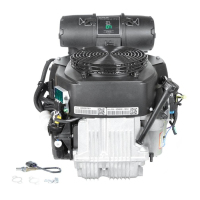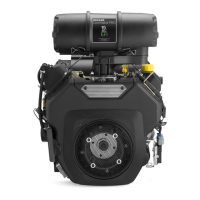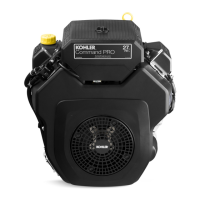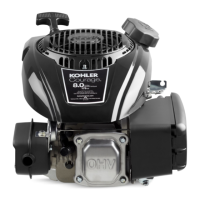6.2
Section 6
Lubrication System
Figure 6-3. Oil Fill Cap/Dipstick.
3. Unscrew and remove the oil fi ll cap/dipstick;
wipe off oil. Reinsert the dipstick into the oil fi ll
tube and rest the cap on the tube. Do not thread
the cap onto the tube.
4. Remove the oil fi ll cap/dipstick and check oil
level is correct. The correct oil level is between
the F and L marks on the dipstick. See Figure 6-4.
Check Oil Level
The importance of checking and maintaining
the proper oil level in the crankcase cannot be
overemphasized. Check oil BEFORE EACH USE as
follows:
1. Make sure the engine is stopped, level, and is
cool so the oil has had time to drain into the
sump.
2. Clean the area around and beneath the oil fi ll
cap/dipstick before removing it. This will help
keep dirt, debris, and other foreign ma er out of
the engine. See Figure 6-3.
5. If the level is low, add oil of the proper type
(Refer to Oil Recommendations on page 6.1) and
to the correct level. Always check the level before
adding more oil.
NOTE: To prevent extensive engine wear or
damage, always maintain the oil level
within the Operating Range.
6. Reinstall the oil fi ll cap/dipstick and tighten on oil
fi ll tube.
Oil Disposal
Protect and respect the environment. Dispose of oil
at your local recycling center or municipal collection
center in accordance with local ordinances.
Changing Oil and Oil Filter
Changing Oil
Change oil a er every 100 hours of operation (more
frequently under severe conditions). Refi ll with oil as
specifi ed in the Viscosity Grades Table. See Figure 6-1.
Change the oil while the engine is still warm. The oil
will fl ow more freely and carry away more impurities.
Make sure the engine is level when fi lling, checking,
or changing the oil.
Figure 6-5. Oil Drain Plug (Starter Side).
Figure 6-4. Oil Level Marks on Dipstick.
Oil Drain
Oil Fill
Cap
Dipstick
Operating
Range

